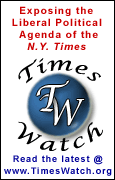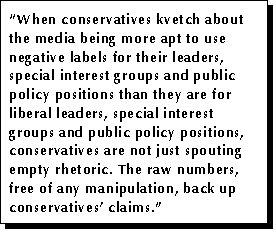 |
|||||||||
|
 |
||
|
 |
||||||||||||||||||||||||
|
||||||||||||||||||||||||
 |
||||||
|
||||||
 |
||||||
|
 |
||||||||||||||||||
|
||||||||||||||||||
 |
||||||||||||||||||||||||
|
||||||||||||||||||||||||
 |
||||||||||||||||||
|
||||||||||||||||||
|
|
|
For Immediate Release: Katie Wright (703) 683-5004 - Wednesday, May 3, 2000 CNN Editor Denounces As "Crock" Discovery of Great Gap Between Liberal and Conservative Labeling NationalJournal.com Finds Liberal Bias Eron Shosteck writes a media column called "Pencil Necks" for National Journal.com. Last week, he made an unusual declaration: "Writing about the political print press without addressing the eternal question of bias is like trying to avoid a confrontation with the obstrep-erous drunkard at your intimate dinner party." Shosteck decided to evaluate media bias by doing a Nexis database search of "English-language news" for certain politically loaded terms. He found liberal favoritism: Extremists. "A Nexis search of 'extreme right' over the past 90 days was 'interrupted' because it exceeded 1,000 documents, which seems to bog down Nexis' data retrieval system. So we narrowed down our investigation time-frame. A Nexis search of 'extreme right' over the past month scored 212 mentions; a Nexis search of 'extreme left' over the past month yielded 58 items. This search reveals that the print media label right-wingers 'extreme' nearly four times more often than they label left-wingers 'extreme.'" Hard Right/Left. "Nexis search for print media uses of 'hard right' over the past 90 days: 683. Nexis search for print media uses of 'hard left' over the past 90 days: 312. Again, the media are apt to label an individual or group 'hard right' more than twice as often than they are apt to label an individual or group 'hard left.'" Far Right/Left. "Nexis search of 'far right' over past week: 267 (past 90 days and 30 days yielded more than 1,000 documents). Nexis search of 'far left' over past week: 130....the media are more than twice as likely to label a conservative person or group as 'far right' than they are to label a liberal person or group 'far left.' Shosteck concluded: "When conservatives kvetch about the media being more apt to use negative labels for their leaders, special interest groups and public policy positions than they are for liberal leaders, special interest groups and public policy positions, conservatives are not just spouting empty rhetoric. The raw numbers, free of any manipulation, back up conservatives' claims." Reaction. After each ideological discrepancy, Shosteck argued that there are an equal number of extreme figures on the left as there are on the right. Media figures did not agree. In an e-mail to Jim Romenesko's MediaNews Web site (www.poynter.org/medianews), CNN Interactive Technology Editor D. Ian Hopper complained: "The National Journal 'investigation' was a crock. In a Democratic administration, coming after an impeachment, of course we'd read quite a bit about the 'far right.' The 'left' is winning, so they don't need to be so vocal. I seriously doubt we'll see a similar check for time periods during the Reagan-Bush administration." (Emphasis his.) Take this, CNN. The September 1991 issue of MRC's MediaWatch documented the use of "left wing" and "right wing" terms in The Washington Post during 1990. Post reporters used "right-wing" 394 times, "left-wing" only 87. On extreme terms (extreme, far, hard, etc.), the numbers were 106 on the right, 24 on the left. -- Tim Graham
Home | News Division
| Bozell Columns | CyberAlerts |







 Partisans.
The term "'partisan Republican'...has turned up 85 times in the English-language news media over the past 90 days. By contrast, the term 'partisan Democrat' has turned up only 58 times in the same time period." That's a ratio of 1.5 to 1.
Partisans.
The term "'partisan Republican'...has turned up 85 times in the English-language news media over the past 90 days. By contrast, the term 'partisan Democrat' has turned up only 58 times in the same time period." That's a ratio of 1.5 to 1.